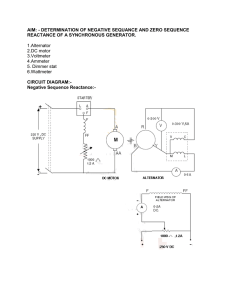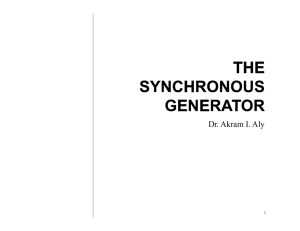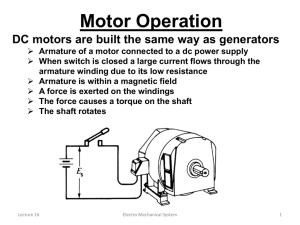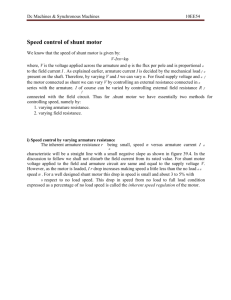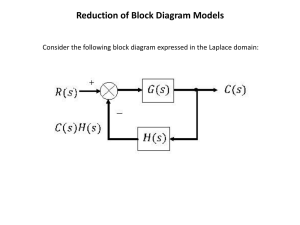Synchronous Machine
advertisement
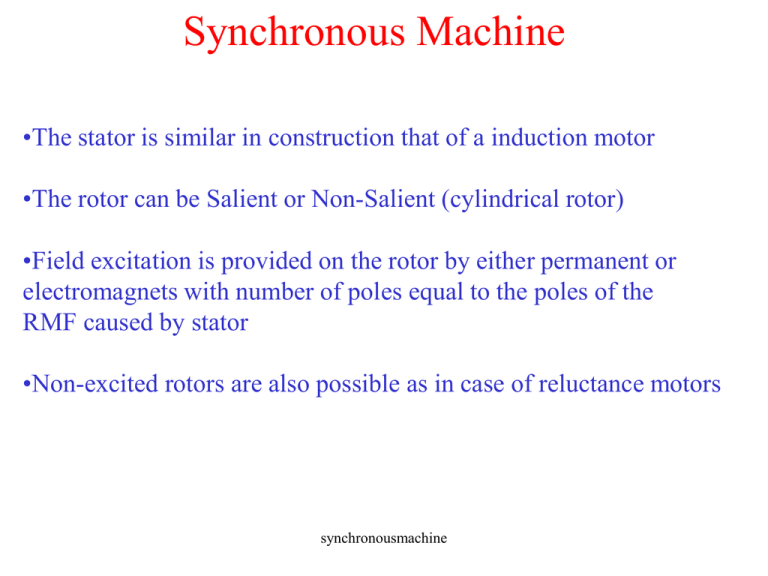
Synchronous Machine •The stator is similar in construction that of a induction motor •The rotor can be Salient or Non-Salient (cylindrical rotor) •Field excitation is provided on the rotor by either permanent or electromagnets with number of poles equal to the poles of the RMF caused by stator •Non-excited rotors are also possible as in case of reluctance motors synchronousmachine Synchronous Machine (2) •The rotor gets locked to the RMF and rotates unlike induction motor at synchronous speed under all load condition •All conventional power plants use synchronous generators for converting power to electrical form •They operate at a better power factor and higher efficiency than equivalent induction machines synchronousmachine Synchronous Machine Construction (a)CRSM (b) SPSM synchronousmachine Concept of synchronous reactance (1) • Like dc machines synchronous machines will also have armature reaction. However unlike dc machine we do not like to eliminate it, but try to use it to our benefit. •Essentially, this armature reaction will determine how much power can be transferred to or from the synchronous machine and limits the current that is flowing in the synchronous machine and hence provides inherent short-circuit protection: a great boon when we are talking about zillions of megawatts of power flow! synchronousmachine Concept of synchronous reactance (2) •Suppose we short-circuit a synchronous generator with the field circuit excited. By Faraday’s law an emf will be induced in the stator (armature) which by Lenz’s law has to oppose the original field on the rotor. It means the resulting armature reaction will induce an opposing emf to the one produced by the main field. •One way to represent this is the following circuit where Xar conjures up the effect of armature reaction. This can be proved as follows: Suppose the original field flux is f= m cost. By Farday’s and Lenz’s law this would produce a voltage Ef= Em sint. This voltage produce a current and hence flux that opposes f, under short-circuit. This current then has to of the form Isc=-Im cost. Clearly Ef/jXar= Em sint/jXar would give such a current. synchronousmachine Equivalent circuit of CRSM (1) Machine Generator (Appx.) Machine Motor(Appx.) Machine Machine Generator (Exact) Motor(Exact) •Only difference is in current direction; in a generator it flows out of it, in case of a motor it flows into it. synchronousmachine Equivalent circuit of CRSM (2) Machine Machine Motor(Exact) Generator (Exact) Xs=Xar+Xal (Synchronous reactance) Zs= Ra+jXs (Synchronous impedance) Xal is leakage Reactance Ra is armature resistance synchronousmachine Phasor diagram of CRSM Note: is +ve for (a) generator and –ve for (b) motor synchronousmachine Derivation of power equation for CRSM on the green board synchronousmachine Effect of Load Change (Field constant) Note: Er same as Ef Va same as Vt Ra has been neglected synchronousmachine Effect of Field Change (Load constant) Note: Er same as Ef Va same as Vt Ra has been neglected Question: 1)Why is the loci of stator current and excitation voltage moves on a straight line? 2) What is happening to power factor as field is changed? synchronousmachine V curves synchronousmachine Effect of Field Change (Load constant) for a generator a Power Ia2 Ef2 jIa2Xs Ef1 jIa1Xs Ia1 Vt synchronousmachine a Power Conclusion for effect for field change with constant load on power factor •For motor with increased (decreased)excitation power factor becomes leading (lagging) •For generator with increased (decreased) excitation power factor becomes lagging (leading) •Unloaded overexcited synchronous motors are sometimes used to improve power factor. They are known as synchronous condensers synchronousmachine Torque versus Electrical Load Angle Normalized Torque, Power 1 0.5 Generator 0 Motor -0.5 -1 Tmax,Pmax -3 -2 -1 0 1 Delta(Radians) synchronousmachine 2 3 Torque versus Speed synchronousmachine Example 1 A six-pole 60 Hz synchronous motor is operating with a developed power of 5 hp and a torque angle of 5o. Find the speed and developed torque. Suppose that the load increases such that the developed torque doubles. Find the new torque angle. Find the pull-out torque and maximum developed power for this machine. synchronousmachine Example 2 An eight-pole, 240 V-rms, 60 Hz, delta connected synchronous motor operates with a constant developed power of 50 hp and a torque angle of 15o and unity power factor. Suppose the field current is increased by 20%. Find the new torque angle and power factor. Is the new power factor lagging or leading? Assume linear magnetic characteristics. synchronousmachine SPSM and the concept of Direct and Quadrature Axes Since in the salient pole machine the reluctance of the machine varies with the position of the pole, flux due to armature reaction varies with power factor. Thus Xar alone is no longer sufficient for the equivalent circuit. Reluctance is minimum along polar (direct) axis. Hence component of the armature reaction acting along this axis produce maximum flux. Let this component be ad. Reluctance is maximum along the inter-polar (quadrature )axis. Hence the component of the armature reaction acting along this axis produce minimum flux. Let this component be aq. synchronousmachine SPSM and the concept of Direct and Quadrature Axes (2) Xd=Xad+Xal=(d)irect axis synchronous reactance) Xq=Xaq+Xal= (q)uadrature axis synchronous reactance) Xad= d(irect) axis armature reactance =Lad Xaq = (q)uadrature axis armature reactance=Laq Xal = leakage reactance ad=LadId aq=LaqIq Id= d(irect) axis component of the armature current Iq = (q)uadrature axis component of the armature current Ia=Iq±jId synchronousmachine Explaining d-q axes using diagrams synchronousmachine Equivalent circuits of SPSM synchronousmachine Power Angle Characteristics of SPSM synchronousmachine Examples on SPSM synchronousmachine
